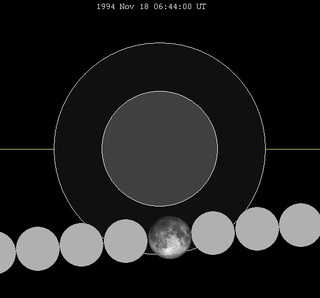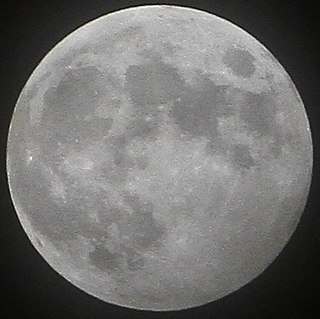
A penumbral lunar eclipse took place on Friday, November 18, 1994, the second of two lunar eclipses in 1994, the first was a partial lunar eclipse on Wednesday, May 25.
Contents
This event followed the total solar eclipse of November 3, 1994.

A penumbral lunar eclipse took place on Friday, November 18, 1994, the second of two lunar eclipses in 1994, the first was a partial lunar eclipse on Wednesday, May 25.
This event followed the total solar eclipse of November 3, 1994.
| Lunar eclipse series sets from 1991–1994 | ||||||||
|---|---|---|---|---|---|---|---|---|
| Ascending node | Descending node | |||||||
| Saros | Date Viewing | Type Chart | Gamma | Saros | Date Viewing | Type Chart | Gamma | |
| 110 | 1991 Jun 27  | Penumbral | −1.40641 | 115 | 1991 Dec 21  | Partial | 0.97094 | |
| 120 | 1992 Jun 15  | Partial | −0.62887 | 125 | 1992 Dec 9  | Total | 0.31438 | |
| 130 | 1993 Jun 4  | Total | 0.16376 | 135 | 1993 Nov 29  | Total | −0.39941 | |
| 140 | 1994 May 25  | Partial | 0.89334 | 145 | 1994 Nov 18  | Penumbral | −1.10479 | |
| Last set | 1991 Jul 26 | Last set | 1991 Jan 30 | |||||
| Next set | 1995 Apr 15 | Next set | 1995 Oct 08 | |||||
A lunar eclipse will be preceded and followed by solar eclipses by 9 years and 5.5 days (a half saros). [1] This lunar eclipse is related to two total solar eclipses of Solar Saros 152.
| November 12, 1985 | November 23, 2003 |
|---|---|
 |  |

A penumbral lunar eclipse took place on April 24, 2005, the first of two lunar eclipses in 2005. At maximum eclipse, 86.5% of the Moon's disc was partially shaded by the Earth, which caused a slight shadow gradient across its disc; this subtle effect may have been visible to careful observers. No part of the Moon was in complete shadow. The eclipse lasted 4 hours and 6 minutes overall, and was visible from east Asia, Australia, and the Americas.

A penumbral lunar eclipse took place on 14 March 2006, the first of two lunar eclipses in 2006.

A penumbral lunar eclipse took place on November 20, 2002, the last of three lunar eclipses in 2002.

A penumbral lunar eclipse took place on May 26, 2002, the first of three lunar eclipses in 2002.

A penumbral lunar eclipse occurred on 28 November 2012, the second of two lunar eclipses in 2012.

A partial lunar eclipse took place on 25 April 2013, the first of three lunar eclipses in 2013. Only a tiny sliver (1.48%) of the Moon was covered by the Earth's umbral shadow at maximum eclipse, but the entire northern half of the Moon was darkened from being inside the penumbral shadow. This was one of the shortest partial eclipses of the Moon for the 21st century, lasting 27 minutes. This was the last of 58 umbral lunar eclipses of Lunar Saros 112.

A penumbral lunar eclipse took place on 18–19 October 2013, the last of three lunar eclipses in 2013.

A penumbral lunar eclipse took place on Sunday, January 31, 1999, the first of two lunar eclipses in 1999.

A penumbral lunar eclipse took place at the Moon's ascending node on 11 February 2017, the first of two lunar eclipses in 2017. It was not quite a total penumbral lunar eclipse. It occurred the same day as comet 45P/Honda–Mrkos–Pajdušáková made a close approach to Earth. It also occurred on the Lantern Festival, the first since 9 February 2009. Occurring only 4.4 days after perigee, the moon's apparent diameter was larger.

A partial lunar eclipse took place on Wednesday, May 25, 1994, the first of two lunar eclipses in 1994, the second being with a penumbral lunar eclipse on Friday, November 18.
A penumbral lunar eclipse took place on Thursday, March 3, 1988, the first of two lunar eclipses in 1988, the second being on August 27, 1988. Earlier sources compute this as a 0.3% partial eclipse lasting under 14 minutes, and newest calculations list it as a penumbral eclipse that never enters the umbral shadow. In a rare total penumbral eclipse, the entire Moon was partially shaded by the Earth, and the shading across the Moon should have been quite visible at maximum eclipse. The penumbral phase lasted for 4 hours, 53 minutes and 50.6 seconds in all, though for most of it, the eclipse was extremely difficult or impossible to see. The Moon was 2.2 days after apogee, making it 6.1% smaller than average.
A penumbral lunar eclipse took place on Tuesday, April 14, 1987, the first of two lunar eclipses in 1987, the second being on October 7, 1987. This subtle penumbral eclipse may have been visible to a skilled observer at maximum eclipse. 77.703% of the Moon's disc was partially shaded by the Earth, which caused a gentle shadow gradient across its disc at maximum; the eclipse as a whole lasted 3 hours, 54 minutes and 12.8 seconds. The Moon was just 4.6 days before perigee, making it 0.5% larger than average.
A penumbral lunar eclipse took place on Thursday, November 8, 1984, the last of three lunar eclipses in 1984. This subtle penumbral eclipse may have been visible to a skilled observer at maximum eclipse. 90% of the Moon's disc was partially shaded by the Earth, which caused a gentle shadow gradient across its disc at maximum; the eclipse as a whole lasted 4 hours and 28 minutes.
A penumbral lunar eclipse took place on Tuesday, May 15, 1984, the first of three lunar eclipses in 1984. This was a deep penumbral eclipse, with the southern limb of the Moon close to the Earth's shadow.
A penumbral lunar eclipse took place on Tuesday, December 20, 1983, the second of two lunar eclipses in 1983. At the maximum eclipse, 89% of the Moon's disk was partially shaded by the Earth, which caused a slight shadow gradient across its disc; this subtle effect may have been visible to careful observers. No part of the Moon was in complete shadow. The eclipse lasted 4 hours and 2 minutes overall.
A penumbral lunar eclipse will take place on Monday, March 25, 2024. It will be visible to the naked eye as 95.57% of the Moon will be immersed in Earth's penumbral shadow.

A partial lunar eclipse will take place on November 30, 2039. At 3 hours 26 minutes, it is the longest partial lunar eclipse since November 19, 2021, which is the previous member of Lunar Saros 126.
A partial lunar eclipse took place on Thursday, May 13, 1976, the first of two lunar eclipses in 1976, the second being a penumbral lunar eclipse on November 6, 1976. At maximum eclipse, a small bite out of the Moon should have been visible. The eclipse lasted for 1 hour, 15 minutes and 23.8 seconds, with just 12.17% of the Moon in shadow at maximum. Occurring only 1.1 days after perigee, the Moon's apparent diameter 5.4% larger than average.
A penumbral lunar eclipse took place on Saturday, November 6, 1976, the second of two lunar eclipses in 1976, the first being on May 13. This subtle penumbral eclipse may have been visible to a skilled observer at maximum eclipse. 83.827% of the Moon's disc was partially shaded by the Earth, which caused a gentle shadow gradient across its disc at maximum; the eclipse as a whole lasted 4 hours, 25 minutes and 52.1 seconds. Occurring only 0.3 days after apogee, the moon's apparent diameter was 6.5% smaller than average.
A penumbral lunar eclipse took place on Wednesday, April 2, 1969, the first of three penumbral lunar eclipses in 1969, the second being on Wednesday, August 27, and the last being on Thursday, September 25. This subtle penumbral eclipse may have been visible to a skilled observer at maximum eclipse. 70.337% of the Moon's disc was partially shaded by the Earth, which caused a gentle shadow gradient across its disc at maximum; the eclipse as a whole lasted 3 hours, 43 minutes and 46.9 seconds. Occurring only 4.2 days before perigee, the Moon's apparent diameter was 0.9% larger than average.